ESP HONDA PRELUDE 1992 User Guide
[x] Cancel search | Manufacturer: HONDA, Model Year: 1992, Model line: PRELUDE, Model: HONDA PRELUDE 1992Pages: 225, PDF Size: 2.1 MB
Page 78 of 225
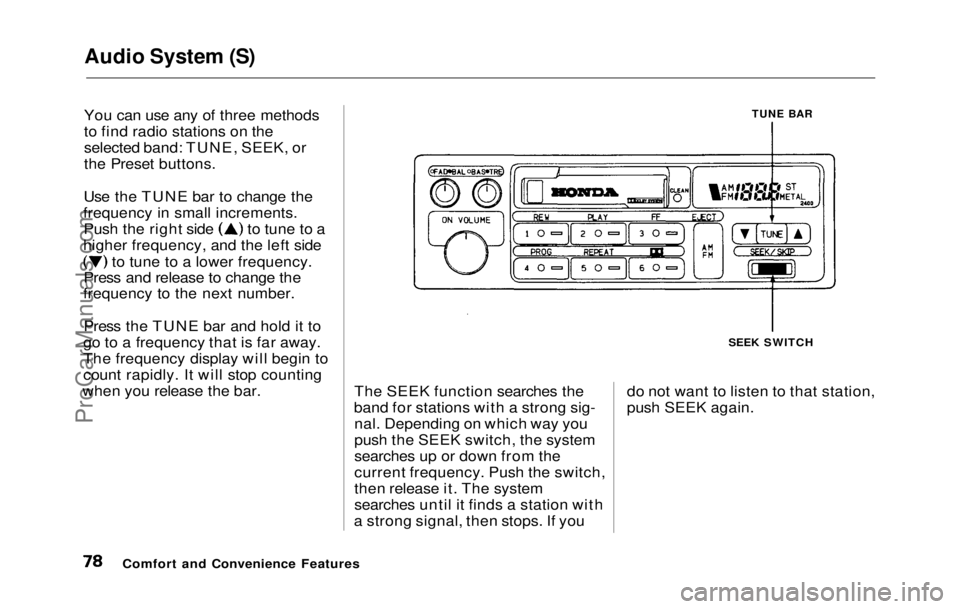
Audio System (S)
You can use any of three methods
to find radio stations on the
selected band: TUNE, SEEK, or
the Preset buttons.
Use the TUNE bar to change the
frequency in small increments. Push the right side to tune to a
higher frequency, and the left side to tune to a lower frequency.
Press and release to change the
frequency to the next number.
Press the TUNE bar and hold it to
go to a frequency that is far away.
The frequency display will begin to
count rapidly. It will stop counting
when you release the bar.
TUNE BAR
The SEEK function searches the
band for stations with a strong sig- nal. Depending on which way you
push the SEEK switch, the system
searches up or down from the
current frequency. Push the switch,
then release it. The system
searches until it finds a station with
a strong signal, then stops. If you SEEK SWITCH
do not want to listen to that station,
push SEEK again.
Comfort and Convenience FeaturesProCarManuals.comMain Menu Table of Contents s t
Page 80 of 225
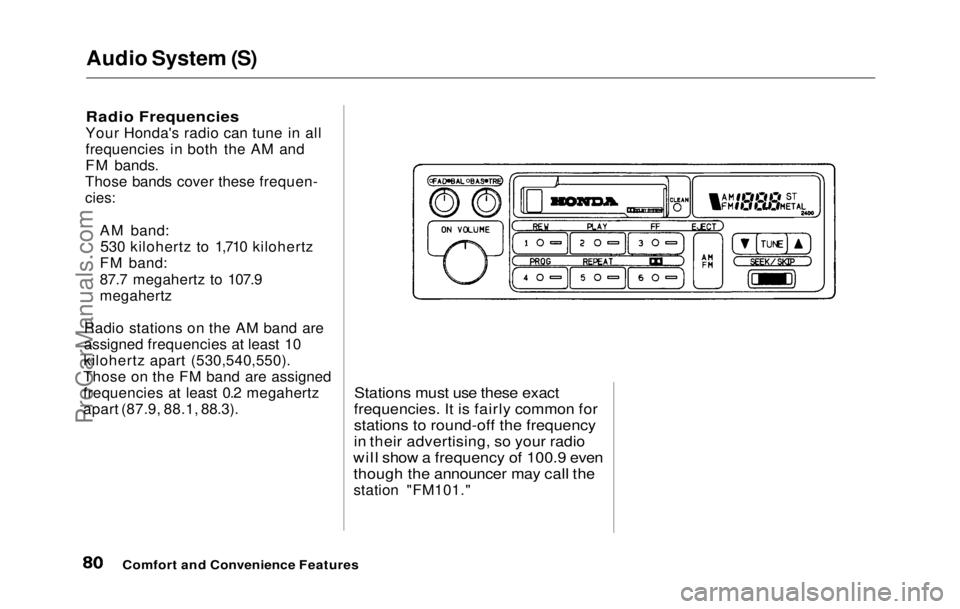
Audio System (S)
Radio Frequencies
Your Honda's radio can tune in all
frequencies in both the AM and
FM bands.
Those bands cover these frequen-
cies:
AM band:530 kilohertz to 1,710 kilohertz
FM band:
87.
7 megahertz to 107.9
megahertz
Radio stations on the AM band are
assigned frequencies at least 10
kilohertz apart (530,540,550).
Those on the FM band are assigned
frequencies at least 0.2 megahertz
apart (87.9, 88.1, 88.3).
Stations must use these exact
frequencies. It is fairly common for
stations to round-off the frequency
in their advertising, so your radio
will show a frequency of 100.9 even though the announcer may call the
station "FM101."
Comfort and Convenience FeaturesProCarManuals.comMain Menu Table of Contents s t
Page 90 of 225
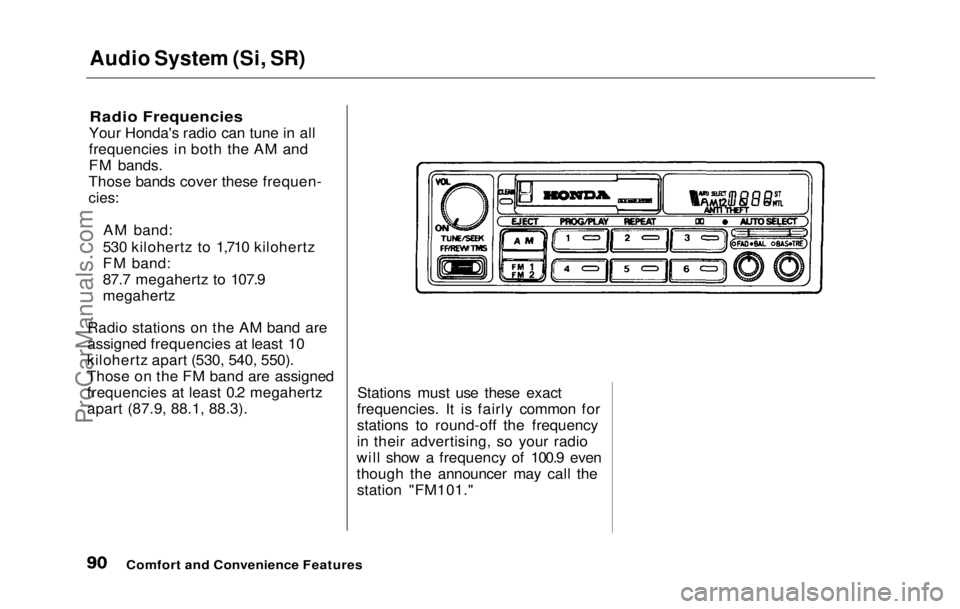
Audio System (Si, SR)
Radio Frequencies
Your Honda's radio can tune in all
frequencies in both the AM and
FM bands.
Those bands cover these frequen-
cies:
AM band:
530 kilohertz to 1,710 kilohertz
FM band:
87.7 megahertz to 107.9
megahertz
Radio stations on the AM band are
assigned frequencies at least 10
kilohertz apart (530, 540, 550).
Those on the FM band are assigned
frequencies at least 0.2 megahertz
apart (87.9, 88.1, 88.3). Stations must use these exact
frequencies. It is fairly common for
stations to round-off the frequency
in their advertising, so your radio
will show a frequency of 100.9 even
though the announcer may call the station "FM101."
Comfort and Convenience FeaturesProCarManuals.comMain Menu Table of Contents s t
Page 95 of 225

Theft Protection
Theft Protection is standard on the Si and Si 4WS models in the U. S.,
and the SR and SR 4WS models in
Canada.
Your audio system is protected by a code number. The system immedi-
ately disables itself whenever the
radio/player unit is disconnected
from the battery. To make it work again, you must enter a five-digit
code with the station Preset
buttons.
Your dealer should have given you
two copies of your audio system's
code number with your car. Keep one of these copies at home, and
the other in your wallet or a con- cealed place in the car. If your car's battery is discon-
nected or goes dead, the audio
system will disable itself. The next
time you turn on the radio you will
see "Code" in the frequency display.
Use the Preset buttons to enter the
five-digit code. If entered correctly,
the radio will start to play.
You will then have to store your
favorite stations in the Preset
buttons. Your original settings
were lost when power was discon-
nected.
Comfort and Convenience FeaturesProCarManuals.comMain Menu Table of Contents s t
Page 98 of 225
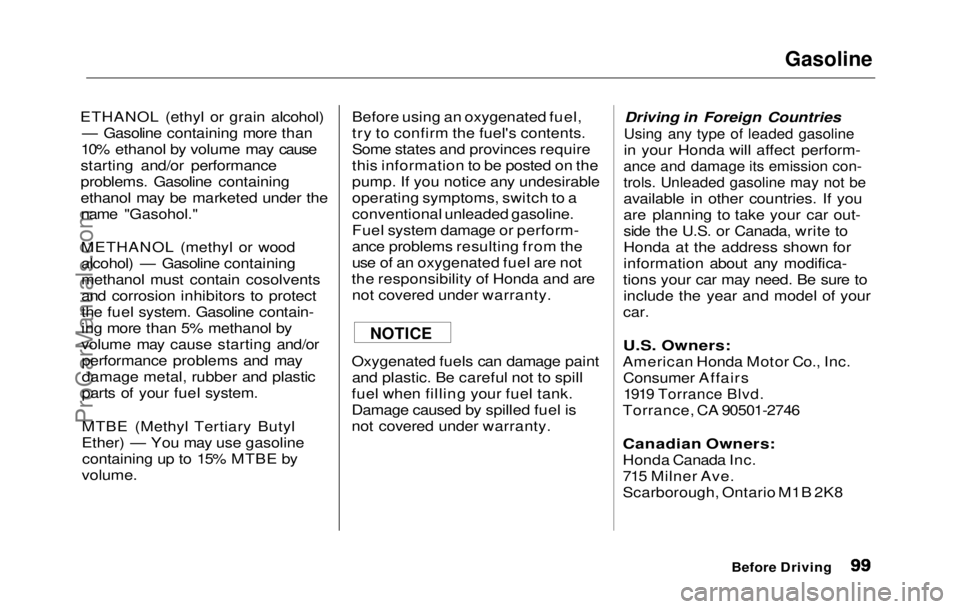
Gasoline
ETHANOL (ethyl or grain alcohol) — Gasoline containing more than
10% ethanol by volume may cause
starting and/or performance
problems. Gasoline containing
ethanol may be marketed under the name "Gasohol."
METHANOL (methyl or woodalcohol) — Gasoline containing
methanol must contain cosolvents
and corrosion inhibitors to protect
the fuel system. Gasoline contain-
ing more than 5% methanol by
volume may cause starting and/orperformance problems and may
damage metal, rubber and plastic
parts o f
your fuel system.
MTBE (Methyl Tertiary Butyl
Ether) — You may use gasoline containing up to 15% MTBE by
volume.
Before using an oxygenated fuel,
try to confirm the fuel's contents.
Some states and provinces require
this information to be posted on the
pump. If you notice any undesirable
operating symptoms, switch to a
conventional unleaded gasoline.
Fuel system damage or perform-
ance problems resulting from the
use of an oxygenated fuel are not
the responsibility of Honda and are not covered under warranty.
Oxygenated fuels can damage paint and plastic. Be careful not to spill
fuel when filling your fuel tank.
Damage caused by spilled fuel is
not covered under warranty. Driving in Foreign Countries
Using any type of leaded gasoline
in your Honda will affect perform-
ance and damage its emission con-
trols. Unleaded gasoline may not be
available i
n
other countries. If you
are planning to take your car out-
side the U.S. or Canada, write to
Honda at the address shown for
information about any modifica-
tions your car may need. Be sure to include the year and model of your
car.
U.S. Owners:
American Honda Motor Co., Inc. Consumer Affairs
1919 Torrance Blvd.
Torrance, CA 90501-2746
Canadian Owners:
Honda Canada Inc.
715 Milner Ave.
Scarborough, Ontario M1B 2K8
Before Driving
NOTICEProCarManuals.comMain Menu Table of Contents s t
Page 117 of 225
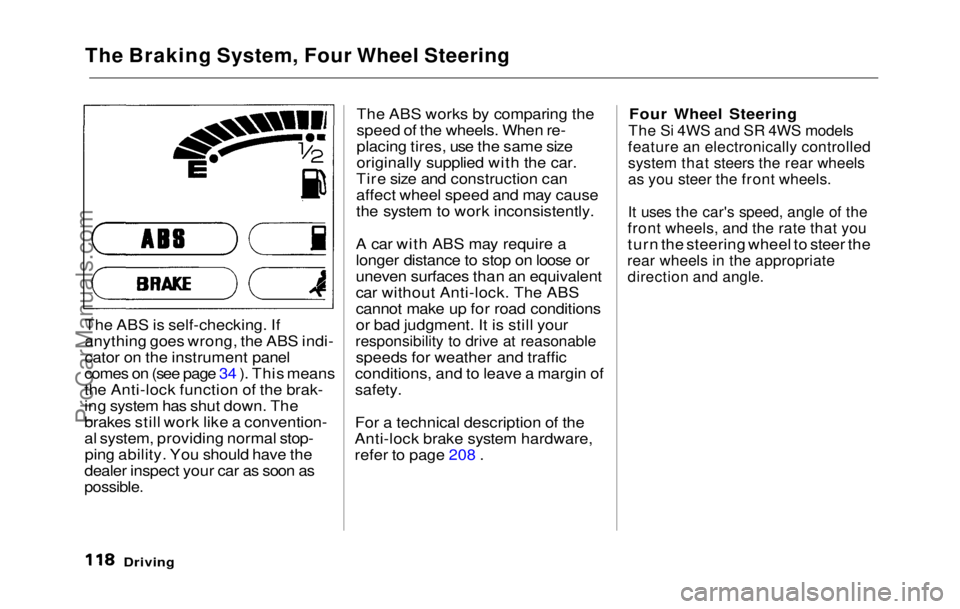
The Braking System, Four Wheel Steering
The ABS is self-checking. If
anything goes wrong, the ABS indi-
cator on the instrument panel
comes on (see page 34 ). This means
the Anti-lock function of the brak-
ing system has shut down. The
brakes still work like a convention-
al system, providing normal stop- ping ability. You should have the
dealer inspect your car as soon as
possible.
The ABS works by comparing the
speed of the wheels. When re-
placing tires, use the same size
originally supplied with the car.
Tire size and construction can
affect wheel speed and may cause
the system to work inconsistently.
A car with ABS may require a
longer distance to stop on loose or
uneven surfaces than an equivalent
car without Anti-lock. The ABS
cannot make up for road conditions
or bad judgment. It is still yourresponsibility to drive at reasonable
speeds for weather and
traffic
conditions, and to leave a margin of
safety.
For a technical description of the
Anti-lock brake system hardware,
refer to page 208 . Four Wheel Steering
The Si 4WS and SR 4WS models
feature an electronically controlled
system that steers the rear wheels
as you steer the front wheels.
It uses the car's speed, angle of the
front wheels, and the rate that you
turn the steering wheel to steer the
rear wheels in the appropriate
direction and angle.
DrivingProCarManuals.comMain Menu Table of Contents s t
Page 119 of 225

Driving in Bad Weather
Driving Technique — Always
drive slower than you would in dry
weather. It takes your car longer to react, even in conditions that may
seem just barely damp. Apply
smooth, even pressure to all the
controls. Abrupt steering wheel
movements or sudden, hard appli-
cation of the brakes can cause loss
of control in wet weather. Be extra
cautious for the first few miles of
driving while you adjust to the change in driving conditions. This
is especially true in snow. A person
can forget some snow-driving tech- niques during the summer months.
Practice is needed to relearn those
skills.
Exercise extra caution when
driving in rain after a long dry spell.
After months of dry weather, the
first rains bring oil to the surface of
the roadway, making it slippery. Visibility — Being able to see
clearly in all directions and being
visible to other drivers are impor-
tant in all weather conditions. This is more difficult in bad weather. To
be seen more clearly during day-
light hours, turn on your headlights.
Inspect your windshield wipers and
washers frequently. Keep the wind- shield washer reservoir full of the
proper fluid. Replace the wind-
shield wiper blades if they start to
streak the windshield or leave parts
unwiped. Use the defrosters and air conditioner to keep the windows
from fogging up on the inside (see
page 73).
Traction — Check your tires
frequently for wear and proper pressure. Both are important in
preventing "hydroplaning" (loss of
traction on a wet surface). In the
winter, mount snow tires on all four
wheels for the best handling.
Watch road conditions carefully, they can change from moment to
moment. Wet leaves can be as slip-
pery as ice. "Clear" roads can have
patches of ice. Driving conditions
can be very hazardous when the
outside temperature is near freez-
ing. The road surface can become
covered with areas of water pud-
dles mixed with areas of ice, so
your traction can change without
warning.
Be careful when downshifting. If
traction is low, you can lock up the
drive wheels for a moment and
cause a skid.
DrivingProCarManuals.comMain Menu Table of Contents s t
Page 124 of 225

Towing a Trailer
Driving
When parking your car and trailer,
especially on a hill, be sure to
follow all the normal precautions.
Turn your front wheels into the curb, set the parking brake firmly,
and put the transmission in 1st or
Reverse (5-speed) or Park (auto-
matic). In addition, place wheel chocks at each of the trailer's tires.
Backing up with a trailer is diffi-
cult and takes practice. Drive
slowly, make small movements
with the steering wheel, and havesomeone stand outside to guide you.
Grip th e
steering wheel on the
bottom (rather than the usual posi- tion near the top). Move your hand
to the left to get the trailer to move
to the left, and right to move the
trailer right.ProCarManuals.comMain Menu Table of Contents s t
Page 160 of 225

Tires
Traction
The traction grades, from highest
to lowest, are A, B, and C, and they
represent the tire's ability to stop
on wet pavement as measured
under controlled conditions on
specified government test surfaces
of asphalt and concrete. A tire
marked C may have poor traction
performance.
Warning: The traction grade as-
signed to this tire is based on brak-
ing (straight ahead) traction tests
and does not include cornering
(turning) traction.
Temperature
The temperature grades are A (the
highest), B, and C, representing the
tire's resistance to the generation
of heat and its ability to dissipate
heat when tested under controlled
conditions on a specified indoor
laboratory test wheel. Sustained
high temperature can cause the
material of the tire to degenerate
and reduce tire life, and excessive
temperature can lead to sudden tire
failure. The grade C corresponds to a level of performance which all
passenger car tires must meet
under the Federal Motor Vehicle
Safety Standard No. 109. Grades B
and A represent higher levels of
performance on the laboratory test
wheel than the minimum required
by law. Warning: The temperature grade
for this tire is established for a tire
that is properly inflated and not
overloaded. Excessive speed,
underinflation, or excessive loading.
either separately or in combination,
can cause heat build-up and
possible tire failure.
MaintenanceProCarManuals.comMain Menu Table of Contents s t
Page 173 of 225
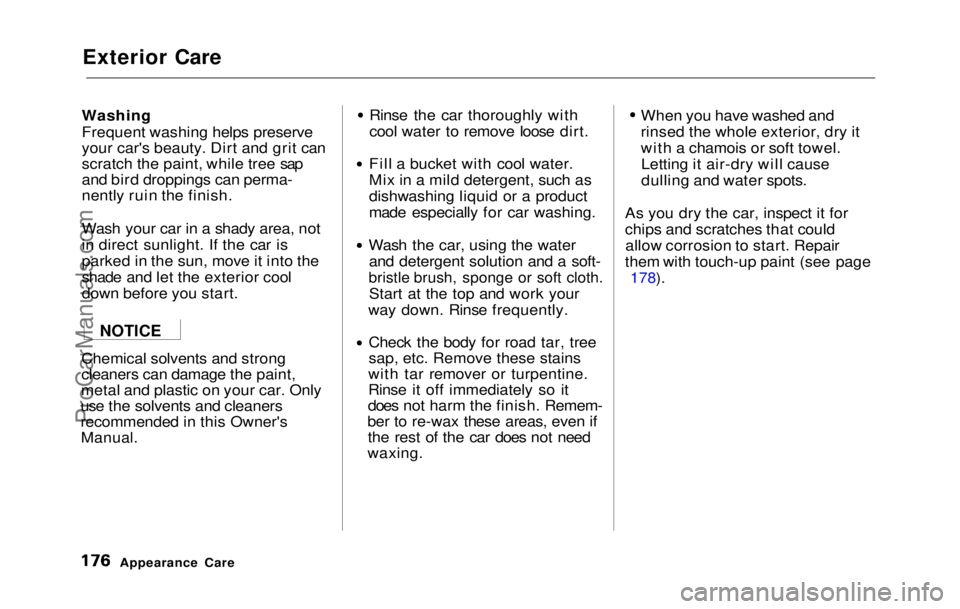
Exterior Care
Washing
Frequent washing helps preserve
your car's beauty. Dirt and grit can
scratch the paint, while tree sap
and bird droppings can perma-
nently ruin the finish.
Wash your car in a shady area, not
in direct sunlight. If the car is
parked in the sun, move it into the
shade and let the exterior cool
down before you start.
Chemical solvents and strong
cleaners can damage the paint,
metal and plastic on your car. Only
use the solvents and cleaners
recommended in this Owner's
Manual.
Rinse the car thoroughly with
cool water to remove loose dirt.
Fill a bucket with cool water.
Mix in a mild detergent, such as
dishwashing liquid or a product
made especially for car washing.
Wash the car, using the water and detergent solution and a soft-bristle brush, sponge or soft cloth.
Start at
the top and work your
way down. Rinse frequently.
Check the body for road tar, tree
sap, etc. Remove these stains
with tar remover or turpentine.
Rinse it off immediately so it
does not harm the finish. Remem-
ber to re-wax these areas, even if the rest of the car does not need
waxing. When you have washed and
rinsed the whole exterior, dry it
with a chamois or soft towel.
Letting it air-dry will cause
dulling and water spots.
As you dry the car, inspect it for
chips and scratches that could allow corrosion to start. Repair
them with touch-up paint (see page
178).
Appearance Care
NOTICEProCarManuals.comMain Menu Table of Contents s t